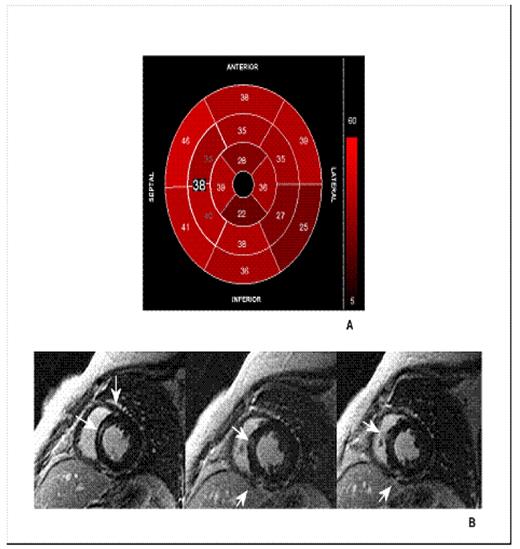Abstract
Cardiovascular Magnetic Resonance (CMR) by delayed enhancement (DE) has proven to visualize myocardial scarring, but no dedicated studies are available in thalassemia major. Aim of our study was to investigate the prevalence, extent, clinical and instrumental correlates of myocardial fibrosis or necrosis by DE CMR in thalassemia major patients. CMR-DE was performed in 115 thalassemia major patients. Myocardial iron overload was determined by multislice multiecho T2*. Cine images were obtained to evaluate biventricular function. All patients gave written informed consent to the protocol. The project was approved by the institutional ethics committee. DE areas were present in 28 patients (24%). Extent of DE was 3.9±2.4 %. In 26 patients the location of fibrosis was not specific and patchy distribution was prevalent. Two patients showed transmural DE following coronary distribution. The DE group was significantly older (P=0.004). DE correlated with cardiac risk factors (P=0.01), history of cardiac complications (P=0.001), anti-HCV antibodies (P = 0.04) and ECG-changes (P=0.002). We did not find significant relation of DE with heart T2* values and biventricular function. Figure shows a thalassemia major patient with no myocardial iron overload (all 16 segments T2* values > 20 ms) (A) and transmural DE (black arrows) following coronary distribution in the apical region (B,C). In conclusion, in thalassemia major patients the significant presence of myocardial fibrosis/necrosis seems to be a time dependent process correlating with cardiovascular risk factors and cardiac complications. HCV infection could be a causal agent in the pathogenesis of myocardial scarring. ECG-changes showed a good accuracy in predicting myocardial scarring.
Disclosures: No relevant conflicts of interest to declare.
Author notes
Corresponding author


This feature is available to Subscribers Only
Sign In or Create an Account Close Modal